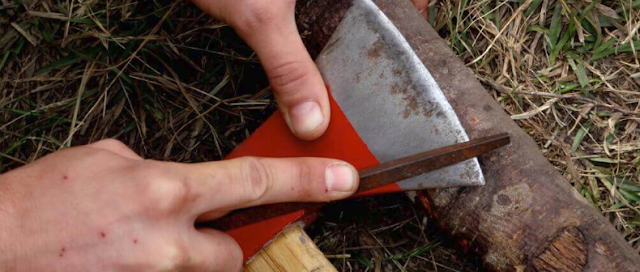🪓How to Properly Sharpen an Axe So It's Fit for a Dwarf
Think back to The Fellowship of the Ring, when Boromir inspects the broken sword Narsil and declares, "Still sharp." It’s a great line, but if you ask a true warrior like Gimli, he’d tell you that a sharp axe is what truly matters when you're facing a horde of orcs. After all, one does not simply walk into Mordor with a dull blade!
It's obvious that you sharpen an axe so it cuts wood better, but the benefits go much deeper. A sharp edge allows you to apply less force, which means you can cut more accurately, for longer, and with far less fatigue. Most importantly, a sharp axe is a safe axe. It bites into the wood exactly where you aim it, reducing the risk of a dangerous glance or slip.
The Science of a Sharp Axe: Geometry and Physics
Sharpening an axe is about more than just creating a fine edge; it's about maintaining the correct blade geometry. The "cheeks" of the axe head (the sloping sides) are designed to part the wood fibers after the "bit" (the cutting edge) makes the initial cut. If this profile is wrong, the axe will get stuck.
When you sharpen, you are creating a new "bevel" at the very edge. This micro-level geometry is what allows the axe to sever wood fibers with minimal force. The famous quote, "give me six hours to chop down a tree and I will spend the first four sharpening the axe," isn't just about being prepared; it's an acknowledgment that a perfectly honed edge makes the physics of cutting work in your favor.
🛠️A Step-by-Step Guide to Sharpening Your Axe
As always, use the right tools, work in a secure space, and prioritize safety. Gloves are highly recommended!
- Preparation is Key: Before you start, clean the axe head. If there's any rust, remove it with a rust eraser, steel wool, or sandpaper. You don't need to polish it to a mirror shine, but you need a clean surface to work with.
- Secure the Axe: An axe must be held stationary while you move the sharpening tool against it. The best way is to clamp it securely in a vice. If you don't have one, a great trick is to place a plank of wood under the axe head to elevate it, then hold the handle down firmly by standing on it.
- Choose Your Tool: You can use either a sharpening stone or a file. A coarse, diamond-coated sharpening stone is ideal for quickly removing metal and establishing a new edge. A good quality mill bastard file also works exceptionally well.
- The Sharpening Motion: With firm, even strokes, push the file or stone across the axe's edge, moving from the inside (heel) to the outside (toe). Always maintain a consistent angle (typically 20-30 degrees) to the blade. Focus on creating a clean, uniform bevel.
- Flip and Repeat: After you've made good progress on one side, flip the axe over and repeat the process on the other side, using the same number of strokes and the same angle to keep the edge symmetrical.
- Check Your Work: You'll know your axe is getting sharp when a small "burr" (a thin ridge of metal) forms along the opposite edge you're working on. Once you've created a burr along the entire length of one side, flip the axe and sharpen the other side until that burr is removed and a new one forms. The final edge should be clean, shiny, and ready to bite into wood.

